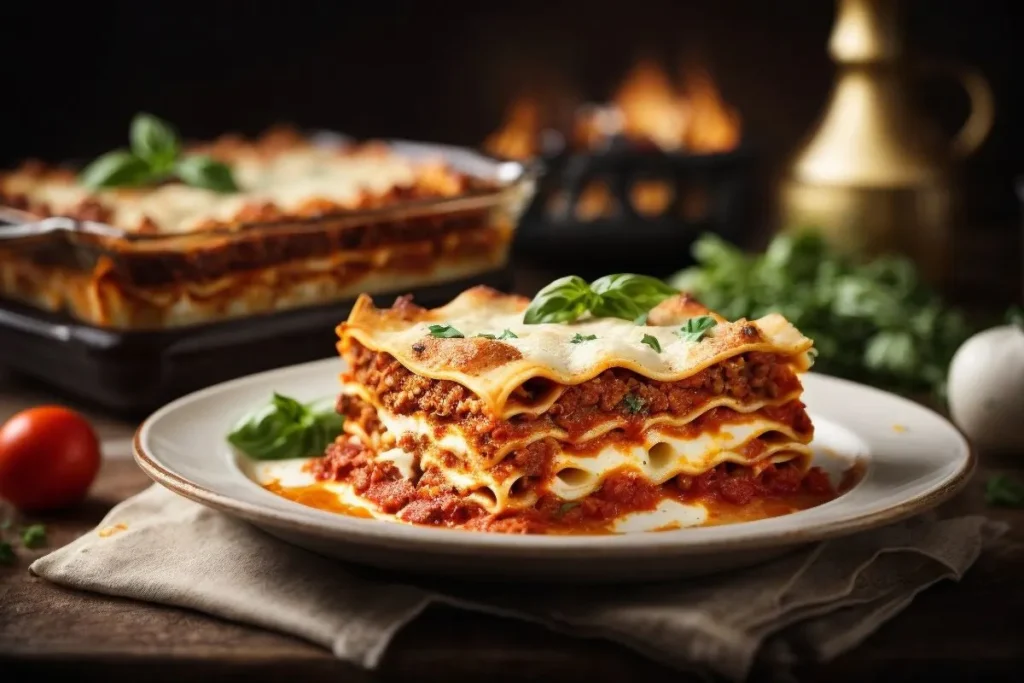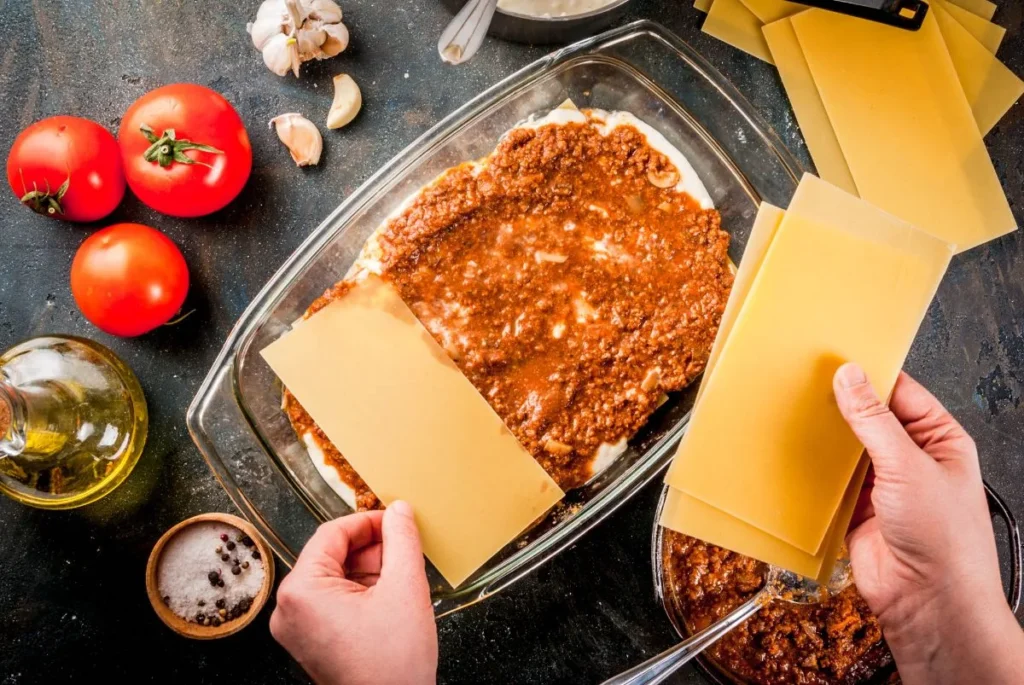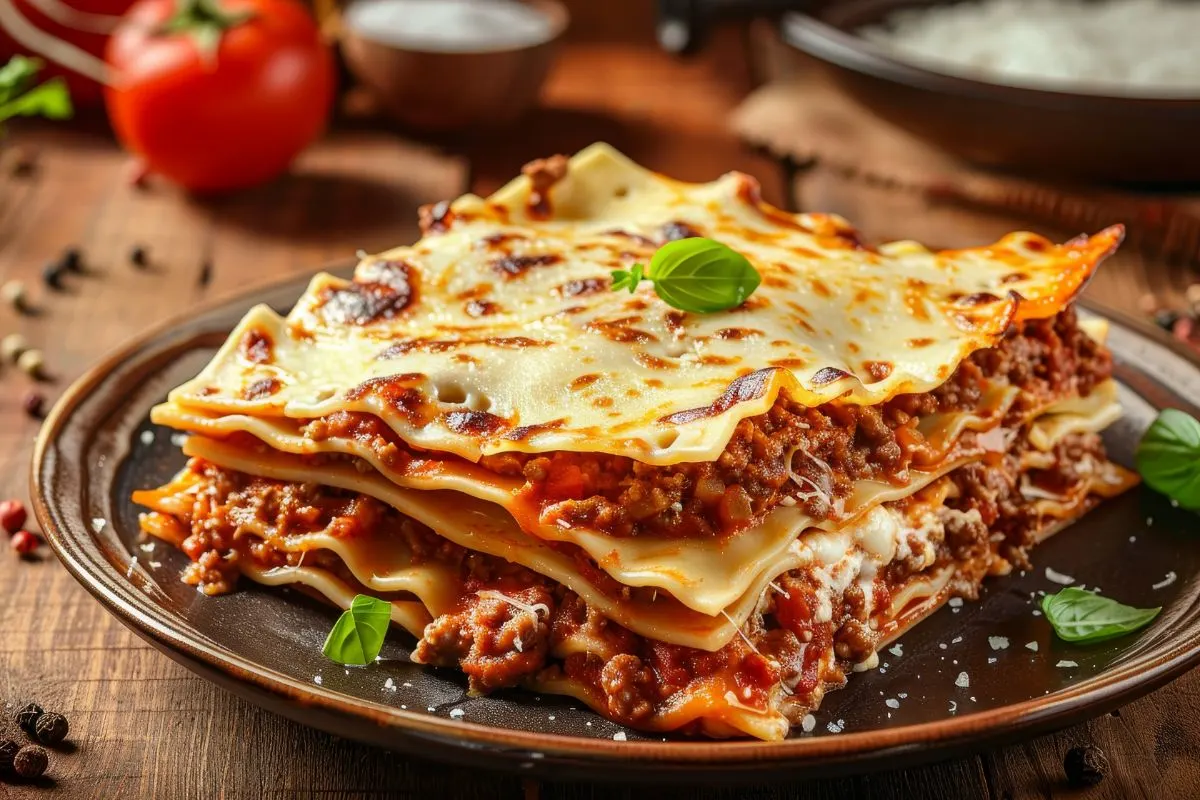Discover the correct layers for lasagna and learn simple steps to build a perfect, flavorful dish.
Introduction
Lasagna stands proudly as one of the world’s most comforting, oven-baked pasta dishes. In fact, it has traveled far from its Italian origins to become a beloved fixture of family dinners in the United States and beyond. It is, therefore, no surprise that many cooks — both novices and seasoned chefs — often find themselves questioning how to assemble it properly. After all, building the correct layers for lasagna is not merely about piling ingredients on top of each other. Instead, it involves a well-planned approach that balances pasta, sauce, cheese, and fillings to achieve that mouthwatering combination of hearty flavor and melt-in-your-mouth texture.
In this detailed guide, we will explore every aspect of proper lasagna layering, from selecting the right noodles to assembling and baking the dish. Moreover, we will delve into the history behind lasagna, discuss ingredient preparation, and even troubleshoot common mistakes. Therefore, by the time you finish reading, you will know how to create a lasagna that remains moist, slices neatly, and delights with every bite. Most importantly, you will gain a deeper understanding of this classic dish, so you can confidently share it with friends and family.
- Introduction
- The Cultural Journey of Lasagna
- Understanding the Correct Layers for Lasagna
- Preparing the Ingredients for Perfect Layers
- Step-by-Step: The Correct Layers for Lasagna
- A Detailed Lasagna Recipe with Correct Layers
- Nutritional Information (per 100g)
- Common Mistakes and How to Avoid Them
- Variations and Dietary Adaptations
- Baking, Resting, and Serving Tips
- FAQ (People Also Ask)
- Conclusion
The Cultural Journey of Lasagna
Where It Began
Lasagna’s roots trace back centuries to Italy. Historically, chefs in the Middle Ages experimented with layered pasta and cheese dishes. Over time, this concept evolved into the lasagna we know today, often associated with Italy’s Emilia-Romagna region. There, the dish commonly includes layers of fresh spinach pasta, rich ragù, béchamel sauce, and Parmesan cheese. However, when it crossed the Atlantic and reached the United States, lasagna adapted to local tastes.
An Italian-American Classic
Many American versions use dried lasagna noodles and emphasize ricotta cheese, mozzarella, and a tomato-based meat sauce. In addition, each household may have its own “secret” formula or layering method. This cultural blend explains why lasagna varies so much from one home to another. Yet, in spite of these differences, a stable structure of layers remains essential to the quality of the final product.
Understanding the Correct Layers for Lasagna

The Key Components
In order to master lasagna layering, it helps to understand each component’s role. Traditionally, there are four main elements:
- Noodles: These provide the structural foundation.
- Sauce: Whether a hearty tomato sauce or creamy béchamel, sauce adds moisture and flavor.
- Cheese: Commonly ricotta, mozzarella, and Parmesan, cheese imparts richness and unites the layers.
- Fillings (Meat or Vegetables): Ground beef or turkey, spinach, mushrooms, or other veggies offer taste, texture, and variety.
Balancing these layers is crucial. Each forkful should contain a bit of everything. Therefore, layering with care ensures that the dish does not collapse and that no single ingredient overwhelms the others.
Why Proper Layering Matters
When assembled correctly, the layers meld into a cohesive whole. The noodles absorb sauce and soften, while cheeses melt and bind the layers together. In addition, proper layering prevents a watery bottom, a dry top, or uneven distribution of flavors. Ultimately, the goal is to achieve a lasagna that holds its shape when sliced but still feels tender and luscious.
Preparing the Ingredients for Perfect Layers
Selecting Your Pasta Noodles
For authentic results, choose lasagna noodles specifically shaped to form thin, flat sheets. Whether you opt for dried or fresh, ensure they are of good quality. Some prefer no-boil noodles, which can streamline preparation. However, if using dried noodles that require boiling, cook them slightly under the recommended time. This prevents them from becoming mushy after baking. Therefore, aim for a texture just shy of al dente, since the noodles will continue to cook in the oven.
Crafting a Flavorful Sauce
A robust sauce anchors each layer. A rich, homemade tomato sauce can add depth. Consider starting from scratch by simmering crushed tomatoes, onion, garlic, and herbs. If you need tips, you might find our Easy Homemade Tomato Sauce helpful. After all, a well-seasoned sauce can make the difference between an ordinary lasagna and an extraordinary one. Make sure the sauce is not too thin; a thick, spoonable consistency helps maintain the structure and prevents the layers from sliding apart.
Choosing the Right Cheeses
Ricotta cheese provides creaminess, while mozzarella lends that gooey melt factor. Sharp Parmesan or Pecorino (if available) adds a savory bite. To achieve the proper layers for lasagna, mix your ricotta with a beaten egg, salt, pepper, and fresh herbs like parsley or basil. This mixture will spread smoothly and maintain its shape when baked. In addition, grate your mozzarella, rather than using pre-shredded, to ensure better melting. A sprinkle of Parmesan between layers contributes extra depth.
Incorporating Meat or Vegetables
Many lasagna recipes call for ground beef or turkey, browned and seasoned, then folded into the sauce or layered directly. Browning the meat first helps intensify flavor and remove excess moisture. For a vegetarian lasagna, consider sautéed spinach, sliced mushrooms, or roasted zucchini. These fillings should be well-drained and seasoned. By doing so, you prevent unnecessary moisture and ensure each layer remains firm.
Step-by-Step: The Correct Layers for Lasagna

To master the correct layers for lasagna, follow these steps carefully. Therefore, set out all your prepared ingredients before you begin assembling. A 9×13-inch baking dish works well, as it allows for multiple layers.
Mastering the Correct Layers for Lasagna
Start with a Sauce Base
Begin by spooning a thin layer of sauce at the bottom of your baking dish. This step prevents the noodles from sticking and helps them cook evenly. Moreover, a base layer of sauce ensures that the bottom doesn’t dry out.
Layer in Your Noodles
Next, lay down a layer of lasagna noodles. Do not overlap them too much; instead, arrange them to cover the surface. If necessary, cut noodles to fit evenly. This first noodle layer provides the initial structure.
Spread the Ricotta Mixture
Carefully spread a layer of your seasoned ricotta cheese mixture over the noodles. This creamy layer contributes to the lasagna’s tender interior. Use the back of a spoon or a spatula to ensure even coverage.
Add Meat or Vegetables
Sprinkle your cooked ground beef or turkey, or arrange your seasoned vegetables, on top of the ricotta. Distribute them evenly. This ensures that each bite offers balanced flavor. In addition, pressing them gently helps keep the layers uniform.
Add Another Layer of Sauce and Cheese
Spoon more sauce over the meat or vegetables, ensuring every surface is covered. Then top it with shredded mozzarella and a light dusting of Parmesan. The combination of these cheeses contributes to lasagna’s signature richness.
Repeat the Sequence
Continue layering noodles, ricotta mixture, meat/vegetables, sauce, and cheese until you have at least three full sets of layers. Three to four layers of noodles is common for a classic lasagna. Therefore, continue until you reach just below the rim of your pan.
Finish with a Saucy, Cheesy Top
For the topmost layer, place noodles, a generous amount of sauce, and finish with mozzarella and Parmesan. Because the top layer browns beautifully, it creates an appealing, golden crust. Do not skimp on sauce here; the top should be moist enough to prevent dryness.
A Detailed Lasagna Recipe with Correct Layers
This recipe serves about 8. Adjust seasonings to your taste.
Ingredients
- 12-15 lasagna noodles (dried, about 3-4 layers total)
- 2 cups tomato sauce (thick and well-seasoned)
- 1 pound ground beef or turkey, browned and drained
- 2 cups ricotta cheese
- 1 large egg, beaten
- 2 cups shredded mozzarella cheese
- ½ cup grated Parmesan cheese
- 2 tablespoons chopped fresh parsley
- Salt and pepper to taste
- Olive oil for coating noodles (optional)
Step-by-Step Instructions
- Preheat the oven:
Preheat your oven to 375°F (190°C). This ensures that once assembled, your lasagna bakes evenly. - Cook the noodles:
Boil the lasagna noodles in salted water until just shy of al dente. Drain and rinse with cool water. Drizzle with a little olive oil to prevent sticking. Set them aside on a clean surface or baking sheet. - Prepare the ricotta mixture:
In a bowl, mix ricotta cheese with the beaten egg, parsley, a pinch of salt, and pepper. Stir until well combined. This mixture will spread more easily and help the layers stay intact. - Assemble the first layer:
In a 9×13-inch baking dish, spread a thin layer of tomato sauce. Lay down a layer of noodles. Spread about 1/3 of the ricotta mixture on top. Sprinkle 1/3 of the browned ground meat evenly over the cheese layer. Spoon sauce over the meat and sprinkle a handful of mozzarella and a light dusting of Parmesan. - Build the subsequent layers:
Repeat the layering: noodles, ricotta mixture, meat, sauce, and cheeses. Continue this pattern until you have 3-4 layers of noodles and end with a top layer of noodles covered in sauce and plenty of mozzarella and Parmesan. - Bake the lasagna:
Cover the baking dish with aluminum foil and place in the preheated oven. Bake for about 25 minutes covered, then remove the foil. Bake an additional 20-25 minutes, or until the cheese on top is golden and bubbly. - Rest before slicing:
Remove the lasagna from the oven and let it rest for at least 15 minutes. This resting period allows the layers to set, making the lasagna easier to slice and serve.
Nutritional Information (per 100g)
| Nutrient | Amount |
|---|---|
| Calories | 170 kcal |
| Protein | 11 g |
| Carbohydrates | 18 g |
| Fat | 6 g |
| Fiber | 1 g |
| Sodium | 320 mg |
Values are approximate and depend on exact ingredients used.
Common Mistakes and How to Avoid Them
Overcooking the Noodles
If noodles become too soft before baking, they may turn mushy. Therefore, slightly undercook them, as the oven will finish the job. This helps your lasagna keep its shape and offers a pleasing bite.
Too Much Liquid
Watery lasagna often occurs when sauces or vegetables are not drained properly. For example, cook your sauce until it thickens. Similarly, ensure vegetables are lightly sautéed and drained. By doing this, you keep the layers firm and stable.
Uneven Distribution of Ingredients
Spreading ingredients evenly is vital. If some parts have more cheese while others have more meat, the lasagna may not hold together well. Therefore, take your time when layering, pressing gently if needed.
Dry Top or Burnt Edges
If the top dries out, you may have baked the dish uncovered for too long. Therefore, start with foil for the initial bake, then uncover for browning. Also, ensure there is enough sauce on the top layer.
Variations and Dietary Adaptations
Regional Twists
Northern Italian versions often use béchamel sauce and spinach-infused pasta. Meanwhile, American-style lasagna relies heavily on tomato sauce and ricotta. Both variations use correct layers for lasagna, simply swapping certain elements.
Vegetarian and Gluten-Free Options
For a vegetarian lasagna, replace meat with sautéed spinach, mushrooms, or roasted vegetables. There are also gluten-free lasagna noodles available. In addition, dairy-free cheeses or tofu-based ricotta can adapt the recipe for those with dietary restrictions while preserving the correct layers for lasagna.
Baking, Resting, and Serving Tips
Baking Techniques
Begin covered to trap moisture, ensuring even cooking. Then, remove the foil for a lovely, golden top. Keep an eye on the oven to avoid burning. In addition, placing the baking dish on a rimmed sheet pan catches any drips.
Resting Before Serving
After baking, let the lasagna rest. Resting is essential, as it allows the layers to settle and firms up the structure. Therefore, give it about 15 minutes before slicing. This waiting time will reward you with picture-perfect slices.
Serving and Storage
Use a sharp, serrated knife to cut portions. Serve with a side salad to lighten the meal. Leftovers keep well in the refrigerator for a few days, and reheating in a microwave or oven is simple. Just add a splash of sauce or water before reheating to maintain moisture.
FAQ (People Also Ask)
Which order lasagne layers?
Start with sauce at the bottom, followed by noodles, then ricotta mixture, then meat or vegetables, and finally more sauce and cheese. Repeat this sequence for multiple layers.
How many layers does authentic lasagna have?
Authentic lasagna typically has three to four layers of noodles, but it varies by region and personal preference. However, aim for at least three sets of layers to achieve a satisfying, well-balanced lasagna.
Do you add egg to ricotta for lasagna?
Yes, adding an egg to the ricotta mixture helps bind the cheese. As a result, the layers stay intact and the lasagna slices more easily.
Conclusion
In conclusion, understanding the correct layers for lasagna is the key to crafting a dish that brings comfort and joy to your table. By balancing noodles, sauce, cheese, and fillings, you ensure every forkful is a perfect blend of flavors and textures. Moreover, paying attention to details such as noodle preparation, sauce thickness, and cheese distribution helps you avoid common pitfalls like watery or dry results. Therefore, as you gain confidence in these techniques, feel free to experiment with ingredients and seasonings. The method remains the same, but the flavors can reflect your personal touch. Most importantly, serve your lasagna with pride, knowing you have created something truly delicious that will keep family and friends coming back for more.

